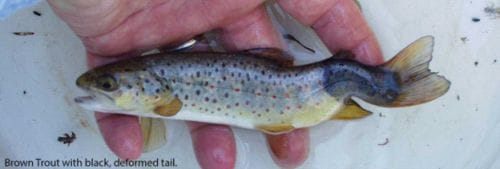If you see sick or dead fish or wildlife, report them to the Ministry of Environment at 1-800-567-4224, toll-free.
Whirling disease is a pathogen caused by a microscopic parasite called Myxobolus cerebralis that affects salmonid fish. The parasite is present in the sediment of waterbodies as spores that are ingested by a particular species of a native aquatic worm (Tubifex tubifex). Once taken up by tubificid worms, the spores produce triactinomyxons (TAMs), which can then infect salmonid species, harming them by causing neurological damage and skeletal deformations.
Where is it found?
The first case of whirling disease identified in Canada was in Johnson Lake within Banff National Park in 2016. It has since been detected in four watersheds within Alberta including Bow River, Oldman River, Red Deer River and the North Saskatchewan River.
To date, whirling disease has not been detected in Saskatchewan. However, since the disease has been confirmed in the North Saskatchewan River and its tributaries in Alberta, there is significant risk as this watershed connects into Saskatchewan at the border near Lloydminster. The disease has also recently been detected in British Columbia. More information about whirling disease management in these provinces can be found on this site.
Signs and symptoms
Whirling disease can be hard to detect as not all affected fish shows signs of infection. Therefore, the detection of whirling disease in fish, aquatic worms, water or sediment often requires laboratory testing for confirmation.
Fish that do display physical signs of infection have been known to exhibit the following symptoms:
- Deformities of the body, head, or tail;
- Blackened tail; and
- Swimming in a “whirling,” tail-chasing behaviour.
Whirling disease does not affect all salmonid fish uniformly. Younger life stages of fish are most susceptible to the disease, where reports have estimated up to 90 per cent mortality of young populations.

Transmission
Whirling disease can spread both naturally and by human activities. The parasite cannot spread from fish to fish; however, it can spread naturally when spores found in water and sediment are transmitted to aquatic tubifex worms, producing TAMs, which are the free-swimming version of the parasite. TAMs can attach to the gills and bodies of salmonids. Spores can then be naturally released into the aquatic environment through the gills and feces of affected organisms, as well as from the decomposition of decaying bodies.
Spores of whirling disease are highly resistant and can persist within waterbodies for more than 20 years. Because of this, there is a high risk for humans to transport the parasites to other waterbodies while boating, angling or recreationally using affected waterbodies. Whirling disease can be spread between waterbodies by:
- Transportation of equipment used for boating, fishing, paddling, scuba diving, swimming and pumping water using equipment that was not properly cleaned, drained and dried before use;
- Transportations of infected fish and fish parts; and
- Movement of mud, sand and water.
Impacts
Whirling disease can negatively impact the environment (declines of fish populations), the economy (reductions in tourism, costs associated with managing the disease) and society (decreased value of waterbodies, loss of angling opportunities). The mortality of young salmonid species inhibits the ability of populations to successfully reproduce. Trout, whitefish and salmon are often sought by sport fishers, and therefore a decline in their populations could reduce recreational and economic value of these waterbodies and decrease tourism.
How to stop the spread
- Take extra precautions if you are travelling to or from a whirling disease area (i.e.: SW Alberta) to clean, drain and dry your watercraft, gear, bait, live wells, waders, boots and equipment.
- Do not transport fish (dead or live), bait, sediment or water from affected waterbodies.
- Dispose of cleaned fish in a proper garbage disposal and sanitize all filleting equipment.
- Become familiar with whirling disease and inform others of the impacts and signs.
- Take a photo or collect the affected fish by humanely euthanizing and double bagging to store in a freezer.

